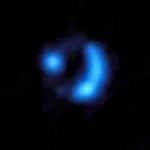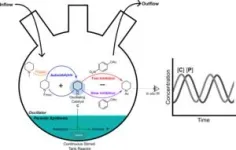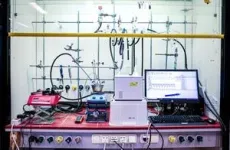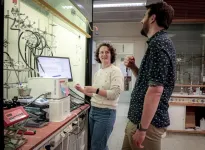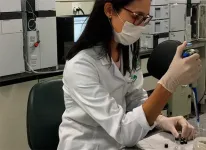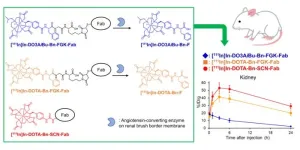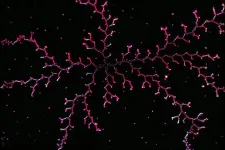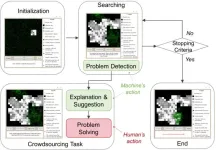(Press-News.org) Using the Atacama Large Millimeter/submillimeter Array (ALMA), astronomers have detected the magnetic field of a galaxy so far away that its light has taken more than 11 billion years to reach us: we see it as it was when the Universe was just 2.5 billion years old. The result provides astronomers with vital clues about how the magnetic fields of galaxies like our own Milky Way came to be.
Lots of astronomical bodies in the Universe have magnetic fields, whether it be planets, stars or galaxies. “Many people might not be aware that our entire galaxy and other galaxies are laced with magnetic fields, spanning tens of thousands of light-years,” says James Geach, a professor of astrophysics at the University of Hertfordshire, UK, and lead author of the study published today in Nature.
“We actually know very little about how these fields form, despite their being quite fundamental to how galaxies evolve,” adds Enrique Lopez Rodriguez, a researcher at Stanford University, USA, who also participated in the study. It is not clear how early in the lifetime of the Universe, and how quickly, magnetic fields in galaxies form because so far astronomers have only mapped magnetic fields in galaxies close to us.
Now, using ALMA, in which the European Southern Observatory (ESO) is a partner, Geach and his team have discovered a fully formed magnetic field in a distant galaxy, similar in structure to what is observed in nearby galaxies. The field is about 1000 times weaker than the Earth’s magnetic field, but extends over more than 16 000 light-years.
“This discovery gives us new clues as to how galactic-scale magnetic fields are formed,” explains Geach. Observing a fully developed magnetic field this early in the history of the Universe indicates that magnetic fields spanning entire galaxies can form rapidly while young galaxies are still growing.
The team believes that intense star formation in the early Universe could have played a role in accelerating the development of the fields. Moreover, these fields can in turn influence how later generations of stars will form. Co-author and ESO astronomer Rob Ivison says that the discovery opens up “a new window onto the inner workings of galaxies, because the magnetic fields are linked to the material that is forming new stars.”
To make this detection, the team searched for light emitted by dust grains in a distant galaxy, 9io9 [1]. Galaxies are packed full of dust grains and when a magnetic field is present, the grains tend to align and the light they emit becomes polarised. This means that the light waves oscillate along a preferred direction rather than randomly. When ALMA detected and mapped a polarised signal coming from 9io9, the presence of a magnetic field in a very distant galaxy was confirmed for the first time.
“No other telescope could have achieved this,” says Geach. The hope is that with this and future observations of distant magnetic fields the mystery of how these fundamental galactic features form will begin to unravel.
Notes
[1] 9io9 was discovered in the course of a citizen science project. The discovery was helped by viewers of the British BBC television programme Stargazing Live, when over three nights in 2014 the audience was asked to examine millions of images in the hunt for distant galaxies.
More information
This research was presented in a paper to appear in Nature.
The team is composed of J. E. Geach (Centre for Astrophysics Research, School of Physics, Engineering and Computer Science, University of Hertfordshire, UK [Hertfordshire]), E. Lopez-Rodriguez (Kavli Institute for Particle Astrophysics and Cosmology, Stanford University, USA), M. J. Doherty (Hertfordshire), Jianhang Chen (European Southern Observatory, Garching, Germany [ESO]), R. J. Ivison (ESO), G. J. Bendo (UK ALMA Regional Centre Node, Jodrell Bank Centre for Astrophysics, Department of Physics and Astronomy, The University of Manchester, UK), S. Dye (School of Physics and Astronomy, University of Nottingham, UK) and K. E. K. Coppin (Hertfordshire).
The European Southern Observatory (ESO) enables scientists worldwide to discover the secrets of the Universe for the benefit of all. We design, build and operate world-class observatories on the ground — which astronomers use to tackle exciting questions and spread the fascination of astronomy — and promote international collaboration for astronomy. Established as an intergovernmental organisation in 1962, today ESO is supported by 16 Member States (Austria, Belgium, the Czech Republic, Denmark, France, Finland, Germany, Ireland, Italy, the Netherlands, Poland, Portugal, Spain, Sweden, Switzerland and the United Kingdom), along with the host state of Chile and with Australia as a Strategic Partner. ESO’s headquarters and its visitor centre and planetarium, the ESO Supernova, are located close to Munich in Germany, while the Chilean Atacama Desert, a marvellous place with unique conditions to observe the sky, hosts our telescopes. ESO operates three observing sites: La Silla, Paranal and Chajnantor. At Paranal, ESO operates the Very Large Telescope and its Very Large Telescope Interferometer, as well as survey telescopes such as VISTA. Also at Paranal ESO will host and operate the Cherenkov Telescope Array South, the world’s largest and most sensitive gamma-ray observatory. Together with international partners, ESO operates ALMA on Chajnantor, a facility that observes the skies in the millimetre and submillimetre range. At Cerro Armazones, near Paranal, we are building “the world’s biggest eye on the sky” — ESO’s Extremely Large Telescope. From our offices in Santiago, Chile we support our operations in the country and engage with Chilean partners and society.
The Atacama Large Millimeter/submillimeter Array (ALMA), an international astronomy facility, is a partnership of ESO, the U.S. National Science Foundation (NSF) and the National Institutes of Natural Sciences (NINS) of Japan in cooperation with the Republic of Chile. ALMA is funded by ESO on behalf of its Member States, by NSF in cooperation with the National Research Council of Canada (NRC) and the National Science and Technology Council (NSTC) in Taiwan and by NINS in cooperation with the Academia Sinica (AS) in Taiwan and the Korea Astronomy and Space Science Institute (KASI). ALMA construction and operations are led by ESO on behalf of its Member States; by the National Radio Astronomy Observatory (NRAO), managed by Associated Universities, Inc. (AUI), on behalf of North America; and by the National Astronomical Observatory of Japan (NAOJ) on behalf of East Asia. The Joint ALMA Observatory (JAO) provides the unified leadership and management of the construction, commissioning and operation of ALMA.
About the University of Hertfordshire: Defined by the spirit of innovation and enterprise, the University of Hertfordshire has been an innovative, vocation-first educational force for more than 70 years. From our start as a leading educator within Britain’s aeronautical industry to our extensive offering today, we have always specialised in providing the environment and expertise needed to power every kind of potential. For our thriving community of more than 30,000 students from over 140 countries, that means high-quality teaching from experts engaged in groundbreaking research with real-world impact. Access to over 550 career-focused degree options and a chance to study at more than 170 universities worldwide, using outstanding, true to life facilities. And industry connections that offer professional networking opportunities which take talents even further. We are Herts. Herts. Beats Faster. Discover a place where ideas move at a different pace. Visit herts.ac.uk.
Links
Research paper
Photos of ALMA
For journalists: subscribe to receive our releases under embargo in your language
For scientists: got a story? Pitch your research
Contacts
James Geach
Centre for Astrophysics Research, University of Hertfordshire
Hatfield, UK
Email: j.geach@herts.ac.uk
Enrique Lopez Rodriguez
Kavli Institute for Particle Astrophysics and Cosmology, Stanford University
Stanford, California, USA
Email: elopezrodriguez@stanford.edu
Rob Ivison
European Southern Observatory (ESO), Germany; Macquarie University, Australia; Dublin Institute for Advanced Studies, Ireland; University of Edinburgh, Scotland; ARC Centre of Excellence for All Sky Astrophysics in 3 Dimensions, Australia
Email: Rob.Ivison@eso.org
Bárbara Ferreira
ESO Media Manager
Garching bei München, Germany
Tel: +49 89 3200 6670
Cell: +49 151 241 664 00
Email: press@eso.org
Press Office
University of Hertfordshire
Hatfield, UK
Tel: +441707 285770
Email: news@herts.ac.uk
END
Furthest ever detection of a galaxy’s magnetic field
2023-09-06
ELSE PRESS RELEASES FROM THIS DATE:
The first organic oscillator that makes catalysis swing
2023-09-06
Oscillating chemical systems are present at nearly every popular chemistry exhibition – especially the ones that display striking colour changes. But so far there are very few practical uses for these types of reactions beyond timekeeping. In nature, on the other hand, many important life processes such as cell division and circadian rhythms involve oscillations. Scientists at the University of Groningen have now developed an oscillating system that contains a catalyst, and exhibits periodic catalytic activity: this synthetic chemical oscillator can do more than just keep time. A description of this ...
Scripps Research chemists devise a method for C-H activation of alcohols
2023-09-06
LA JOLLA, CA—Scripps Research chemists have extended a powerful molecule-building method—called C-H activation—to the broad class of chemicals known as alcohols.
The synthetic chemistry feat, reported in Nature on September 6, 2023, follows the development of C-H activation techniques for the three other major classes of organic molecule—amines, acids and ketones—that are used to construct pharmaceuticals. It gives chemists a versatile new toolkit for making drugs and other valuable compounds now using the alcohol chemical class; moreover, its ...
Pitt researchers to study Alzheimer’s disease in marmosets
2023-09-06
PITTSBURGH – To reimagine existing preclinical trials for Alzheimer’s disease, University of Pittsburgh School of Medicine neuroscientists created the first non-human primate model of hereditary Alzheimer's in marmoset monkeys, outlining their approach in Alzheimer's & Dementia: Translational Research & Clinical Interventions.
Researchers are now working on characterizing and validating genetic, molecular, functional and cognitive features of aging and Alzheimer’s disease in marmosets that harbor mutations in the same gene that is linked to early-onset disease in humans. Scientists hope to accelerate the pace of the ...
Oral health deteriorates before and after bariatric surgery, study shows
2023-09-06
Oral health deteriorates in morbidly obese people on a diet in preparation for bariatric surgery and patients who have undergone the procedure, with increasing caries, gingivitis and periodontitis. This is the conclusion of a study conducted by researchers at the Federal University of São Paulo (UNIFESP) in Brazil. Articles on the study are published in the Journal of Oral Rehabilitation and Clinical Oral Investigations, stressing the importance of participation by a dentist in the assessment of bariatric patients.
The study was funded by FAPESP (projects 17/26400-6 and 16/10940-9), following 100 patients divided into two groups (dietary ...
Patients with AML who received vitamin C/D supplements had fewer complications, but no overall survival benefit seen
2023-09-06
Patients with acute myeloid leukemia (AML) who received vitamin C and D supplements while undergoing intensive chemotherapy had lower rates of complications, such as infections, bleeding, and inflammation, when compared with similar, previously treated patients who did not receive these supplements. Moreover, while the study showed no difference in survival between the two groups, a subgroup analysis showed that among patients with a genetic mutation known as NPM1 – found in about one in three patients with AML – the risk of death was nearly 50% lower among those ...
University of Colorado ophthalmologists administer novel treatment for single patient facing rare genetic condition
2023-09-06
Thirteen-year-old Grace Hoyt received potentially the best birthday gift ever this month when pediatric ophthalmologists at the University of Colorado School of Medicine and Children’s Hospital Colorado administered the first treatment designed specifically to slow her vision loss associated with posterior column ataxia with retinitis pigmentosa (PCARP), a rare genetic condition that affects vision and the nervous system.
“It’s so incredible that she has this opportunity,” Susan Hoyt says of her daughter, who received the first treatment Aug. 24. “We’ve known that Grace is going to go blind, but to have ...
Novel molecular design for enhanced efficacy and safety in radiotheranostics
2023-09-06
Radiotheranostics embodies the convergence of diagnostic and therapeutic radiopharmaceuticals into a unified platform. In cancer treatment, radiotheranostic procedures typically involve the use of antibodies that bind to proteins abundantly found on the surface of cancerous cells. The antibodies are labeled with a suitable radioisotope, which facilitates imaging procedures used to diagnose cancer and can be used to target cancerous cells and bombard them with deadly radiation as a form of treatment.
Although radiolabeled antibodies show promise as a treatment for cancer, several hurdles impede their clinical translation. ...
Potential target for reversing drug resistance in ovarian cancer identified
2023-09-06
For the 314,000 people diagnosed with ovarian cancer each year, hope often comes in the form of platinum-based drugs such as cisplatin.
Cisplatin causes the death of quick-dividing tumour cells, so it is a potent first-line defence in the treatment of the often fatal disease.
However, over half of ovarian cancer patients develop recurrence and become resistant to cisplatin and other platinum-based chemotherapies, contributing to the five-year survival rate of 31%.
It is unclear why this resistance occurs, but a solution is urgently ...
Human-AI collaboration improves source search outcomes
2023-09-06
When artificial intelligence robots that have been designed to use algorithms to complete source search tasks, such as search and rescue operations during a fire, encounter a disturbance, they are often unable to complete their task. Proposed solutions have ranged from trying to improve algorithms to introducing additional robots, but these AI-driven robots still encounter fatal problems.
Researchers have proposed a solution: a human-AI collaboration that takes advantages of the unique skills of the human brain to overcome challenges.
The paper was published in the Journal of Social ...
Teleneurology challenges met by training curriculum
2023-09-06
A new physician-training system in telehealth simulates key parts of traditional, in-person neurological exams that use little reflex hammers, pinpricks, and flashlights to test nerve function. The three-year program, which was designed by researchers at NYU Grossman School of Medicine, has trained at least 68 neurology residents since its rollout in 2020. Published online Aug. 3 in Neurology Education, a new analysis of the curriculum identifies challenges to translating in-person exam techniques ...
